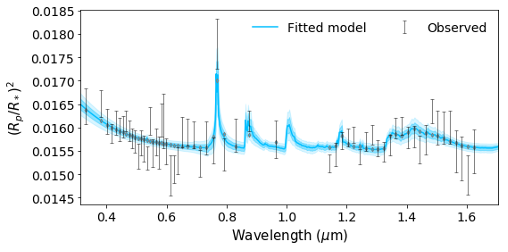Chromium hydride in the atmosphere of hot Jupiter WASP-31b
First evidence for the presence of chromium hydride (CrH) in the atmosphere of a hot Jupiter, or a Jupiter-size planet orbiting close to its host star.
Soon after the first discoveries of exoplanets, their atmospheres also became a curiosity. Nowadays, we have confirmed over 4000 exoplanets, encompassing a wide range of temperatures, sizes and masses1. Naturally, we can expect a wide diversity in their atmospheres. Most atmospheric observations have been made with the Hubble Space Telescope (HST) using transmission spectroscopy. With this technique, we observe the decrease in flux when a portion of the host star’s light is blocked by a planetary transit. The dip varies as a function of wavelength, caused by the specific interaction between light and chemical species in the planetary atmosphere. A nearby example of such an interaction is Earth’s ozone layer, which protects us by absorbing harmful ultraviolet light. Observing a transmission spectrum allows us to infer the constituents of an exoplanet atmosphere.

Since the first atmospheric discovery of sodium (Na) in 2002, a plethora of chemical species has been detected on exoplanets, ranging from water to exotic metal oxides. Besides oxides, metal hydrides are expected in the gaseous phase between temperatures of 1400-2000 K. This inspired us to conduct a retrieval of the transmission spectrum of hot Jupiter WASP-31b. The framework TauREx II2 was used to retrieve the most likely constituents of an atmosphere given the observed spectrum. We found that an atmosphere including absorption by water (H2O), potassium (K) and CrH provides the best match to the observations.
The figure on the right shows the observed spectrum as grey bars and the retrieved atmosphere as the blue line. It shows the variation in the dip of the starlight as a function of wavelength. The presence of H2O leads to increased absorption around 1.4 µm, K leads to strong absorption around 0.77 µm and CrH produces 4 absorption features around 0.8, 0.9, 1.0 and 1.2 µm.
At the retrieved temperature of 1481 K for WASP-31b, CrH is still expected in the gaseous phase. At slightly lower temperatures, CrH may start to form clouds and potentially cause rain that consists of chromium, implying significant variation in the atmospheric chemistry around WASP-31b. In the stages of planet formation, chromium is likely to be in the solid phase. Hence, its presence in an atmosphere hints towards the past accretion of solid material.
Although observations with ground-based telescopes could not confirm the detection, WASP-31b is an exceptional target for further characterisation with NASA’s James Webb Space Telescope (JWST), planned for launch in October 2021. JWST has the potential to confirm our findings and to further uncover this intriguing planet.
The work was led by Marrick Braam, a new PhD student at the Centre for Exoplanet Science, as part of his studies at the Kapteyn Astronomical Institute of the University of Groningen and in collaboration with SRON.
[1] And counting, see NASA’s Exoplanet Archive for the most recent numbers and planetary parameters.
[2] For TauREx II, see https://exoai.github.io/software/taurex/. For version III, see https://taurex3-public.readthedocs.io/en/latest/.
Links:
Braam, M., van der Tak, F. F. S., Chubb, K. L., Min, M., Evidence for chromium hydride in the atmosphere of hot Jupiter WASP-31b, 2021, Astronomy & Astrophysics, in press.

